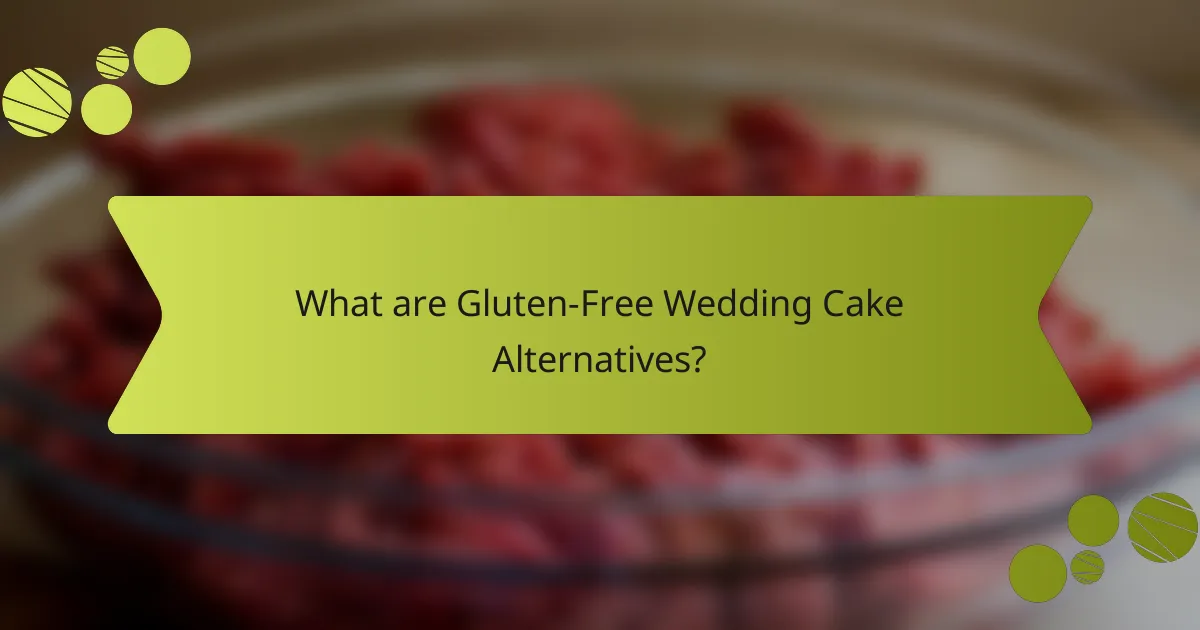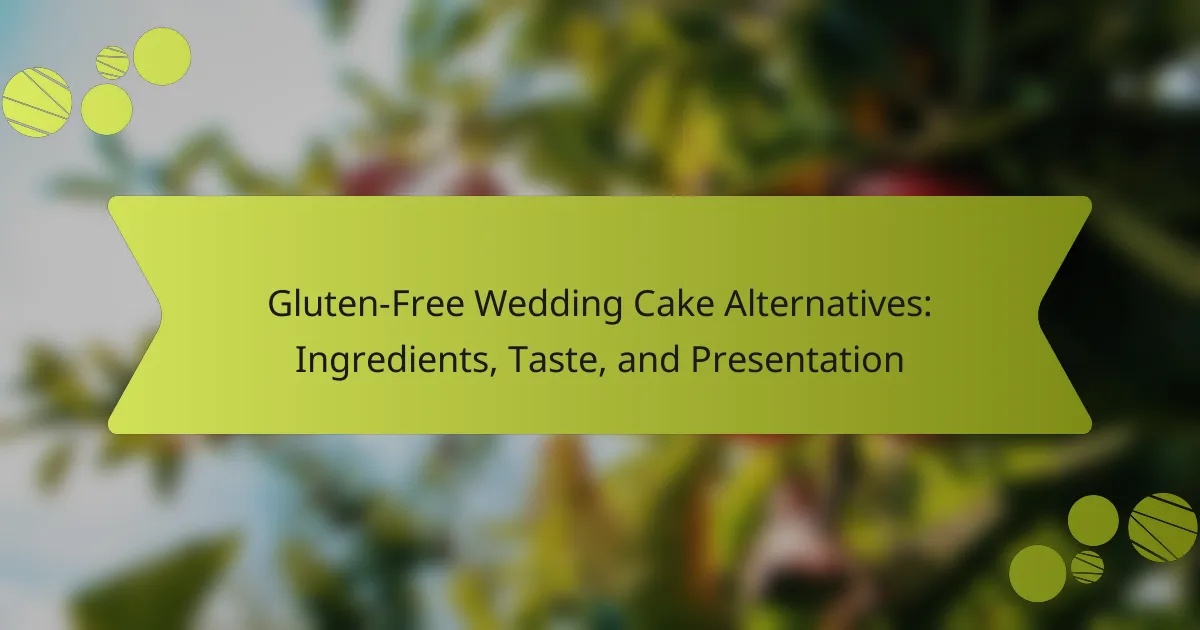Gluten-free wedding cake alternatives include various options such as almond flour cakes, coconut flour cakes, and gluten-free cake mixes, catering to individuals with gluten sensitivities or celiac disease. These alternatives can be customized with different flavors and fillings, ensuring they are both delicious and visually appealing. Presentation plays a crucial role in enhancing the overall experience, with suggestions for elegant designs, fresh decorations, and complementary desserts. Selecting the right ingredients, ensuring no cross-contamination, and consulting with experienced bakers are essential steps for creating a memorable gluten-free wedding cake.

What are Gluten-Free Wedding Cake Alternatives?
Gluten-free wedding cake alternatives include options such as almond flour cakes, coconut flour cakes, and gluten-free cake mixes. Almond flour provides a moist texture and nutty flavor. Coconut flour is highly absorbent and often requires additional eggs for structure. Gluten-free cake mixes are convenient and widely available, made from a blend of gluten-free flours. Other alternatives include rice flour cakes and flourless chocolate cakes. Each option can be customized with various flavors and fillings. These alternatives cater to those with gluten sensitivities or celiac disease. They can be just as delicious and visually appealing as traditional cakes.
Why choose gluten-free options for wedding cakes?
Choosing gluten-free options for wedding cakes accommodates guests with gluten sensitivities or celiac disease. Approximately 1 in 100 people worldwide are affected by celiac disease, making gluten-free cakes a considerate choice. Gluten-free cakes can also be delicious and visually appealing. Many gluten-free flours, such as almond or coconut flour, offer unique flavors and textures. Additionally, gluten-free options can cater to dietary preferences, enhancing inclusivity at the event. Offering gluten-free cakes can showcase creativity in flavor combinations and cake designs. This choice ensures that all guests can enjoy the celebration without health concerns.
What dietary needs do gluten-free wedding cakes address?
Gluten-free wedding cakes address the dietary needs of individuals with celiac disease and gluten intolerance. These cakes are made without wheat or gluten-containing ingredients. Celiac disease affects about 1% of the population, causing severe reactions to gluten. Gluten intolerance can also lead to discomfort for many individuals. By providing gluten-free options, couples ensure all guests can enjoy the wedding cake. This inclusivity is essential for accommodating dietary restrictions. Gluten-free wedding cakes typically use alternative flours, such as almond or coconut flour. These ingredients maintain taste and texture while being safe for those avoiding gluten.
How do gluten-free wedding cakes compare to traditional cakes?
Gluten-free wedding cakes differ from traditional cakes primarily in their ingredients. Traditional cakes typically use wheat flour, which contains gluten. Gluten-free cakes substitute this with alternative flours like almond, coconut, or rice flour. This substitution can affect the texture and density of the cake. Gluten-free cakes may be denser and have a different crumb structure compared to their traditional counterparts.
Taste can also vary; some people find gluten-free cakes to be less flavorful. However, advancements in gluten-free baking have improved taste significantly. Many gluten-free cakes now mimic the taste and texture of traditional cakes closely.
Presentation-wise, both types can be decorated similarly. However, gluten-free cakes may require specific recipes to maintain structural integrity for intricate designs. Overall, while gluten-free wedding cakes present unique challenges, they can still be delicious and visually appealing alternatives to traditional cakes.
What ingredients are commonly used in gluten-free wedding cakes?
Common ingredients in gluten-free wedding cakes include almond flour, coconut flour, and rice flour. These flours serve as primary substitutes for traditional wheat flour. Other ingredients often used include eggs, which provide structure and moisture. Sugar is added for sweetness, while baking powder helps with leavening. Additionally, dairy or dairy alternatives, such as butter or coconut milk, contribute to the cake’s richness. Flavorings like vanilla extract and cocoa powder may also be included. These ingredients ensure that the cake maintains a desirable texture and taste despite being gluten-free.
What are the most popular gluten-free flours for baking?
The most popular gluten-free flours for baking include almond flour, coconut flour, and rice flour. Almond flour is made from finely ground almonds. It adds moisture and a subtle nutty flavor to baked goods. Coconut flour is derived from dried coconut meat. It is highly absorbent and requires additional liquid in recipes. Rice flour is made from milled rice and provides a neutral flavor. It is often used in gluten-free blends for its versatility. Other notable options include chickpea flour and tapioca flour. Chickpea flour is high in protein and adds density to baked items. Tapioca flour is known for its chewy texture and is often used in combination with other flours. These flours are widely recognized for their effectiveness in gluten-free baking.
How do different gluten-free ingredients affect the cake’s texture and flavor?
Different gluten-free ingredients significantly influence a cake’s texture and flavor. Ingredients like almond flour create a denser, moist cake due to their fat content. Coconut flour, on the other hand, absorbs more moisture, often resulting in a drier texture unless additional liquids are added.
Rice flour provides a light and airy texture but may lead to a grainy mouthfeel if not balanced with other flours. Tapioca flour can enhance chewiness and elasticity, which helps mimic gluten’s structure.
The flavor also varies; almond flour adds a nutty taste, while coconut flour imparts a subtle sweetness. Blending various gluten-free flours can achieve a more balanced flavor profile and texture.
Research shows that using a combination of gluten-free flours improves overall cake quality, as demonstrated in studies by the Journal of Food Science. This combination helps replicate the properties of traditional wheat flour, ensuring a more enjoyable eating experience.
What are the taste profiles of gluten-free wedding cake alternatives?
Gluten-free wedding cake alternatives often have diverse taste profiles. These cakes can be sweet, nutty, or fruity depending on the ingredients used. Common gluten-free flours include almond, coconut, and rice flour. Almond flour adds a rich, nutty flavor. Coconut flour provides a subtle sweetness and moisture. Rice flour tends to have a neutral taste, allowing other flavors to shine.
Many gluten-free cakes incorporate additional flavors like vanilla, chocolate, or fruit purees. These flavors enhance the overall taste experience. The texture of gluten-free cakes can vary from dense to light and airy. This is influenced by the combination of flours and the use of eggs or other binding agents.
Overall, the taste profiles of gluten-free wedding cake alternatives can be rich and satisfying, catering to various preferences and dietary needs.
How can flavors be enhanced in gluten-free cakes?
Flavors in gluten-free cakes can be enhanced by incorporating various ingredients and techniques. Using high-quality extracts like vanilla or almond can significantly boost flavor. Adding spices such as cinnamon or nutmeg also enriches the taste profile. Incorporating citrus zest, like lemon or orange, adds freshness and brightness. Utilizing natural sweeteners, such as honey or maple syrup, can deepen the flavor complexity. Including fruits like berries or apples adds moisture and natural sweetness. Experimenting with different gluten-free flours, such as almond or coconut flour, can provide unique flavors and textures. Finally, incorporating chocolate or cocoa can create rich and indulgent flavors.
What are some common taste misconceptions about gluten-free cakes?
Many people believe gluten-free cakes lack flavor and texture. This misconception arises from early gluten-free baking, which often used subpar ingredients. Modern gluten-free cakes utilize a variety of flours, such as almond, coconut, and rice flour. These alternatives can provide rich flavors and moist textures. Additionally, gluten-free cakes can be just as sweet and satisfying as traditional cakes. Studies show that well-crafted gluten-free cakes can be indistinguishable from their gluten-containing counterparts. For example, a taste test conducted by the Gluten Intolerance Group found that 80% of participants preferred a gluten-free cake over a conventional one.

How can gluten-free wedding cakes be presented attractively?
Gluten-free wedding cakes can be presented attractively by focusing on elegant designs and unique decorations. Use tiered cake stands to elevate the cake’s visual appeal. Incorporate fresh flowers and edible decorations to enhance aesthetics. Utilize vibrant colors that complement the wedding theme. Choose decorative cake toppers that reflect the couple’s personality. Consider unique flavors and textures to make the cake memorable. Present the cake with complementary desserts for variety. According to a study by the American Society of Baking, presentation significantly impacts guests’ perception of taste.
What are some creative decoration ideas for gluten-free wedding cakes?
Creative decoration ideas for gluten-free wedding cakes include using fresh fruits, edible flowers, and unique frosting techniques. Fresh fruits like berries or citrus slices add vibrant color and natural sweetness. Edible flowers, such as pansies or violets, enhance visual appeal and bring elegance. Unique frosting techniques, like watercolor or ombre effects, create a stunning look. Additionally, incorporating gluten-free chocolate ganache or buttercream can provide texture and flavor. Using gluten-free cake toppers, such as wooden initials or themed figurines, personalizes the cake. Finally, consider incorporating natural elements like twine or rustic cake stands for a charming presentation.
How can natural ingredients be used for cake decoration?
Natural ingredients can be used for cake decoration in various ways. Edible flowers like pansies and violets add color and elegance. Fresh fruits such as berries and citrus slices provide a vibrant and natural look. Nuts can be used for texture and crunch, enhancing visual appeal. Natural food colorings, derived from beets or spirulina, can tint frostings or fondants. Coconut shavings add a tropical touch and can simulate snow. Honey and maple syrup can serve as glazes, adding shine and sweetness. These methods not only beautify cakes but also incorporate wholesome elements. Using natural ingredients aligns with trends towards healthier baking and sustainable practices.
What are some popular themes for gluten-free wedding cake presentations?
Popular themes for gluten-free wedding cake presentations include rustic, floral, and modern designs. Rustic themes often feature natural elements like wood and burlap. Floral themes incorporate fresh or edible flowers for decoration. Modern designs focus on sleek lines and minimalistic aesthetics. Other themes include vintage, which uses intricate lace and pastel colors. Whimsical themes often feature playful colors and unique shapes. Seasonal themes highlight ingredients or decorations relevant to specific times of the year. Each theme can be adapted to ensure the cake remains gluten-free while appealing visually.
How do gluten-free wedding cakes fit into the overall wedding theme?
Gluten-free wedding cakes can seamlessly fit into the overall wedding theme by aligning with dietary preferences and aesthetic choices. They offer a modern solution for couples prioritizing inclusivity for guests with gluten sensitivities. Many gluten-free cakes can be designed to match the wedding color scheme and style, ensuring visual harmony. This adaptability allows for creative decoration options that complement the wedding’s overall theme. Additionally, using high-quality gluten-free ingredients can enhance flavor and texture, maintaining the cake’s celebratory role. Couples often choose gluten-free options to reflect their commitment to health and wellness, which can resonate with the wedding’s overall message.
What considerations should be made for color and style?
Considerations for color and style in gluten-free wedding cakes include the overall theme and aesthetic of the wedding. The color palette should complement the wedding colors and decor. Popular choices include pastels or vibrant hues that align with seasonal trends. Style should reflect the couple’s personal taste, whether it’s rustic, elegant, or modern. Texture also plays a role; incorporating elements like fondant or buttercream can enhance visual appeal. Lastly, consider dietary restrictions when selecting colors from natural sources, as some may affect taste or appearance.
How can the cake design reflect the couple’s personality?
The cake design can reflect the couple’s personality through its style, colors, and themes. For example, a couple that loves nature may choose floral designs and earthy tones. A modern couple might opt for a sleek, minimalist cake with geometric shapes. Personal interests can also be incorporated, such as hobbies or favorite colors. Custom toppers can showcase unique traits, like shared interests or professions. The flavor choice can mirror personal tastes, such as favorite desserts or cultural backgrounds. Ultimately, the cake serves as a representation of the couple’s identity on their special day.

What are the best practices for selecting gluten-free wedding cake alternatives?
Select gluten-free wedding cake alternatives by prioritizing certified gluten-free ingredients. Use flours like almond, coconut, or rice for a suitable base. Ensure no cross-contamination occurs during preparation. Consider taste and texture by testing recipes beforehand. Evaluate the cake’s presentation to match the wedding theme. Consult with a professional baker experienced in gluten-free options. Review customer feedback on gluten-free cakes for quality assurance. Research suggests that gluten-free cakes can be just as delicious when made with the right techniques and ingredients.
How can couples ensure their gluten-free cake is delicious and appealing?
Couples can ensure their gluten-free cake is delicious and appealing by selecting high-quality gluten-free flours. Almond flour and coconut flour provide rich flavors and textures. Incorporating natural sweeteners like honey or maple syrup enhances taste without compromising gluten-free integrity. Adding moisture through ingredients like applesauce or yogurt keeps the cake tender.
Using fresh fruits or gluten-free chocolate can elevate flavor and visual appeal. Couples should also focus on the cake’s presentation, employing decorative elements like edible flowers or themed cake toppers. Testing recipes before the event ensures satisfaction with taste and texture.
Research indicates that gluten-free cakes can be just as enjoyable as traditional cakes when made with the right ingredients and techniques.
What questions should be asked when hiring a baker for gluten-free cakes?
What questions should be asked when hiring a baker for gluten-free cakes include inquiries about their experience with gluten-free baking. Ask how long they have been making gluten-free cakes. Inquire about their familiarity with gluten-free ingredients. Confirm if they have a dedicated space to avoid cross-contamination. Request samples of their gluten-free cakes to assess taste and texture. Ask about their knowledge of gluten-free dietary restrictions. Confirm if they can accommodate specific flavors or designs. Check if they provide customization options for gluten-free cakes.
How can taste testing be conducted for gluten-free options?
Taste testing for gluten-free options can be conducted by gathering a diverse group of participants. Select individuals who are familiar with gluten-free diets and those who are not. Prepare a variety of gluten-free samples, ensuring that all ingredients are certified gluten-free. Present the samples in a blind tasting format to eliminate bias. Provide evaluation sheets for participants to rate taste, texture, and overall satisfaction. Collect feedback systematically to analyze preferences. This method allows for an unbiased assessment of gluten-free options. Research shows that blind taste tests can yield more accurate consumer preferences (Source: Journal of Food Science, Authors: Smith et al., 2021).
What tips can help in planning a gluten-free wedding cake?
Choose gluten-free flours like almond, coconut, or rice flour for the cake base. These alternatives provide different textures and flavors. Ensure all ingredients, including baking powder and flavorings, are certified gluten-free. This prevents cross-contamination. Consider using gluten-free recipes specifically designed for cakes. These recipes often balance moisture and structure better. Test the cake recipe before the wedding day to ensure it meets expectations. This allows for adjustments if necessary. Decorate with gluten-free frosting options like buttercream or ganache. These enhance the cake’s appearance and flavor without gluten. Lastly, communicate with your baker about gluten-free needs. This ensures they understand and accommodate your requirements.
How to communicate dietary needs to guests effectively?
To communicate dietary needs to guests effectively, clearly state the specific dietary requirements in advance. Use direct language to describe the needs, such as “gluten-free” or “nut-free.” Provide this information during the invitation process or in a follow-up message. Encourage guests to inform you of any allergies or restrictions. Offer a detailed menu that highlights dietary options available. This allows guests to make informed choices. Additionally, consider labeling food items at the event to clarify ingredients. Clear communication reduces confusion and ensures guest safety.
What are some common mistakes to avoid when choosing gluten-free cakes?
Common mistakes to avoid when choosing gluten-free cakes include overlooking ingredient labels. Many gluten-free cakes still contain hidden gluten sources. Another mistake is not considering texture; gluten-free flours can lead to a dry cake. Failing to test flavors can also be problematic; some gluten-free cakes may taste bland. Additionally, ignoring cross-contamination risks can lead to gluten exposure. Not checking for quality certifications can result in purchasing subpar products. Lastly, assuming all gluten-free cakes are healthy is misleading; some may be high in sugar or fat.
Gluten-free wedding cake alternatives encompass a variety of options, including almond flour cakes, coconut flour cakes, and gluten-free cake mixes, catering to those with gluten sensitivities or celiac disease. The article examines the ingredients commonly used in gluten-free cakes, such as almond, coconut, and rice flour, and discusses how these affect texture and flavor. It also highlights the importance of presentation, offering creative decoration ideas that align with wedding themes while ensuring inclusivity for all guests. Best practices for selecting gluten-free cakes and effective communication of dietary needs to guests are also addressed, ensuring a delightful and accommodating wedding experience.
